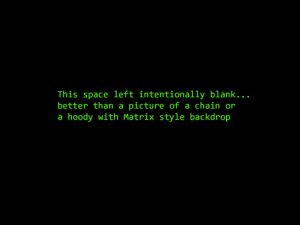- Prologue – covers the overall challenge at a high level
- Part One – Recruiting and Interviews
- Part Two – Threat and Vulnerability Management – Application Security
- Part Three – Threat and Vulnerability Management – Other Layers
- Part Four – Logging
- Part Five – Cryptography and Key Management, and Identity Management
- Part Six – Trust (network controls, such as firewalls and proxies), and Resilience
Fintechs and Security – A Match Made In Heaven?
Well, no. Far from it actually. But again, as i’ve been repeating for 20 years now, its not on the fintechs. It’s on us in infosec, and infosec has to take responsibility for these problems in order to change. If i’m a CTO of a fintech, I would be confused at the array of opinions and advice which vary radically from one expert to another
But there shouldn’t be such confusion with fintech challenges. Confusion only reigns where there’s FUD. FUD manifests itself in the form of over-lengthy coverage and excessive focus on “controls” (the archetypal shopping list of controls to be applied regardless of risk – expensive), GRC, and “hacking/”[red,blue,purple,yellow,magenta/teal/slate grey] team”/”appsec.
Really what’s needed is something like this (in order):
- Threat modelling lite – a one off, reviewed periodically.
- Architecture lite – a one off, review periodically.
- Engineering lite – a one off, review periodically.
- Secops lite – the result of the previous 3 – an on-going protective monitoring capability, the first level of monitoring and response for which can be outsourced to a Managed Service Provider.
I will cover these areas in more details in later episodes but what’s needed is, for example, a security design that only provides the answer to “What is the problem? How are we going to solve it?” – so a SIEM capability design for example – not more than 20 pages. No theory. Not even any justifications. And one that can be consumed by non-security folk (i.e. it’s written in the language of business and IT).
Fintechs and SMBs – How Is The Infosec Challenge Unique?
With a lower budget, there is less room for error. Poor security advice can co-exist with business almost seamlessly in the case of larger organisations. Not so with fintechs and Small and Medium Businesses (SMBs). There has been cases of SMBs going under as a result of a security incident, whereas larger businesses don’t even see a hit on their share price.
Look For A Generalist – They Do Exist!
The term “generalist” is seen as a four-letter word in some infosec circles. But it is possible for one or two generalists to cover the needs of a fintech at green-field, and then going forward into operations, its not unrealistic to work with one in-house security engineer of the right background, the key ingredients of which are:
- Spent at least 5 years in IT, in a complex production environment, and outgrew the role.
- Has flexibility – the old example still applies today – a Unix fan has tinkered with Windows. So i.e. a technology lover. One who has shown interest in networking even though they’re not a network engineer by trade. Or one who sought to improve efficiency by automating a task with shell scripting.
- Has an attack mindset – without this, how can they evaluate risk or confidently justify a safeguard?
I have seen some crazy specialisations in larger organisations e.g. “Websense Security Engineer”! If fintechs approached security staffing in the same way as larger organisations, they would have more security staff than developers which is of course ridiculous.
So What’s Next?
In “On Hiring For DevSecOps” I covered some common pitfalls in hiring and explained the role of a security engineer and architect.
There are “fallback” or “retreat” positions in larger organisations and fintechs alike, wherein executive decisions are made to reduce the effort down to a less-than-advisable position:
- Larger organisations: compliance driven strategy as opposed to risk based strategy. Because of a lack of trustworthy security input, execs end up saying “OK i give up, what’s the bottom line of what’s absolutely needed?”
- Fintechs: Application security. The connection is made with application development and application security – which is quite valid but the challenge is wider. Again, the only blame i would attribute here is with infosec. Having said that, i noticed this year that “threat modelling” has started to creep into job descriptions for Security Engineers.
So for later episodes – of course the areas to cover in security are wider than appsec, but again there is no great complication or drama or arm-waiving:
- Part One – Hiring and Interviews – I expand on “On Hiring For DevSecOps“. I noticed some disturbing trends in 2019 and i cover these in some more detail.
- Part Two – Security Architecture and Engineering I – Threat and Vulnerability Management (TVM)
- Part Three – Security Architecture and Engineering II – Logging (not necessarily SIEM). No Threat Hunting, Telemetry, or Threat “Intelligence”. No. Just logging. This is as sexy as it needs to be. Any more sexy than this should be illegal.
- Part Four – Security Architecture and Engineering III – Identity Management (IDAM) and Cryptography and Key Management (CKM).
- Part Five – Security Architecture and Engineering IV – Trust (network trust boundary controls – e.g. firewalls and forward proxies), and Business Resilience Management (BRM).
I will try and get the first episode on hiring and interviewing out before 2020 hits us but i can’t make any promises!



